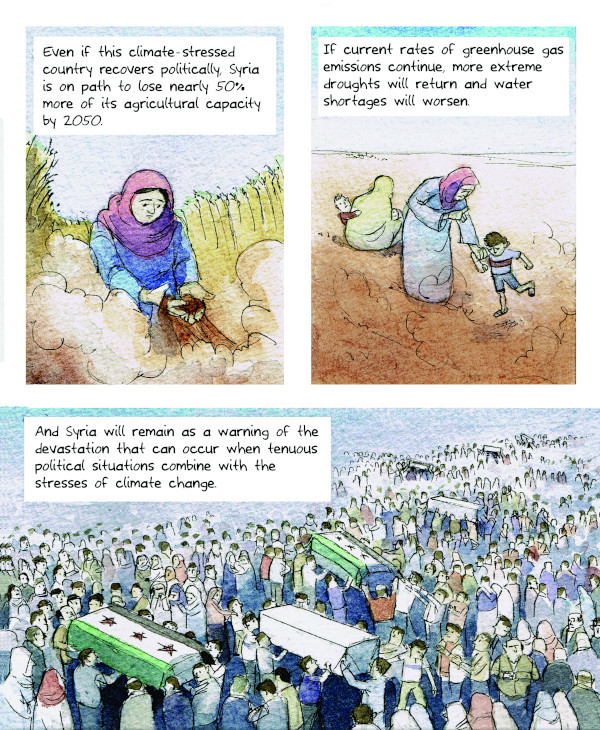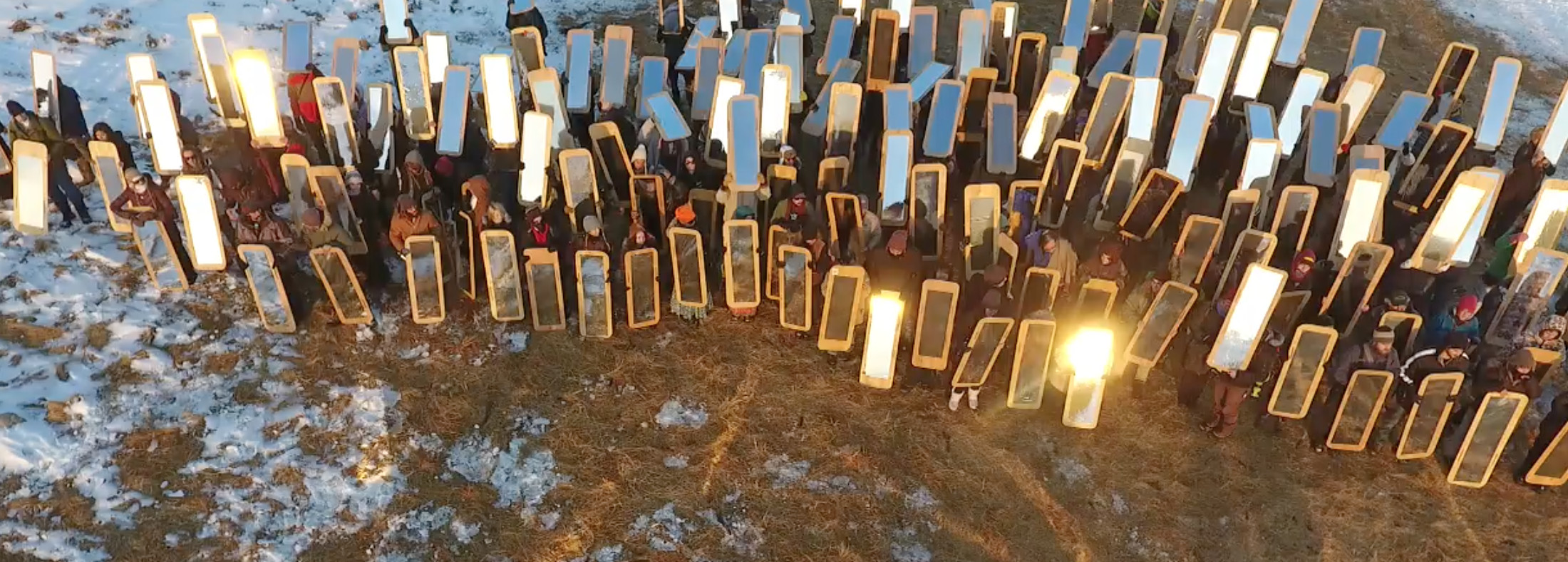
Beyond the end
Imagining better futures in the wake of dystopia
During the often fierce 2016 protests in the vast North Dakota landscape of the Standing Rock Indian Reservation, hundreds of mirror shields glinted in the sun like dappled water. Their purpose? To help the “water protectors” who gripped them side-by-side stand firm in their conviction: the planned Dakota Access Pipeline that would carry oil from western North Dakota to southern Illinois endangered the region’s water and the ancient burial grounds of the Standing Rock Sioux Tribe and other Native American cultural sites. By reflecting their images back at them, the mirrors reminded the riot gear–garbed police of their humanity, said artist and shield designer Cannupa Hanska Luger.
Having grown up on the reservation, Luger had an intimate understanding of the threats posed by the pipeline. Remembering mirrors similarly used by Ukrainian protesters in 2014, he designed long wooden shields covered in unbreakable reflective coatings. After building dozens of the shields with students at the Institute of American Indian Arts, he released a video instructing others how to make them. The video provided an important way for anyone to join the protest, Luger said, prompting supporters to build and send more than a thousand mirrors to the front lines.
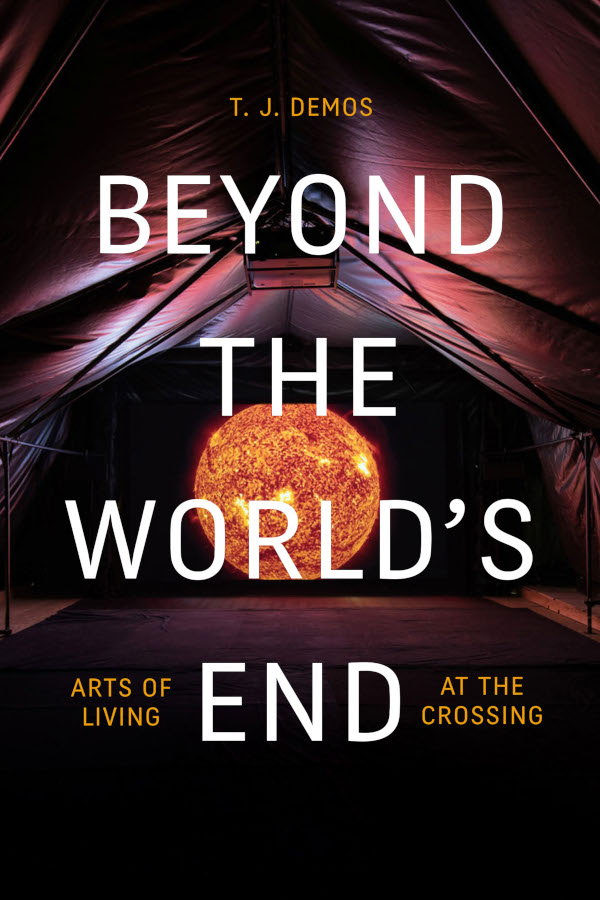
According to T. J. Demos, UC Santa Cruz professor of art history and visual culture, Luger, with his Mirror Shield Project, belongs to an emerging group of artists who employ experimental and unconventional practices to address historically complex and interlinked social and environmental crises. Luger is one of many artists featured in the Demos-directed Beyond the End of the World, a two-year project designed, per the UCSC project’s website, to confront urgent global threats and cultivate “radical futures of social justice and ecological flourishing.”
Demos explored the project’s theme in his similarly titled book, Beyond the World’s End (Duke University Press, 2020). The inventive artist activists Demos has identified, together with leading thinkers and visionary writers, are all addressing socio-ecological crises with “models of aesthetic practice where life is being reinvented in ways that not only critically identify the manifold problems that threaten existence as we know it,” writes Demos, “they also offer diverse approaches to a hopeful futurity beyond the catastrophe of racial and colonial capitalism.”
Radical imaginaries
The project’s conception and expansion grew out of past research and political concerns of Demos, who also created and directs the UCSC Center for Creative Ecologies; it additionally resonated with a growing array of international intellectual and creative practices. Starting in 2018, with support from The Humanities Institute, a $225,000 grant from the Andrew W. Mellon Foundation, and more than 20 collaborators, Demos led the planning and development of a range of thematically related research topics and activities culminating in both his book and the project’s Sawyer Seminar series, film series, and art exhibitions. The latter three series of events during 2020 and 2021 provided forums for international thinkers and cultural practitioners to consider both current challenges and what life might look like in the near and distant future.
According to Demos, the new and radical “imaginaries” that spring from this type of creativity are multifaceted social worlds envisioned and created through the grassroots efforts of art activists who are fighting against wide-ranging and intersecting injustices, including economic inequality, political disenfranchisement, racial and colonial violence, and environmental destruction. By employing and modeling new aesthetic and political forms, Demos said, the artists associated with the project are, in many ways, playing a vital role in challenging ongoing oppression. Fostering this movement are three significant transformations Demos cites having observed in recent art practice: a willingness to step away from art as a commodity presented in rarefied gallery environments; a growing body of work in justice-based art focused on socio-environmental issues; and an increasing use of art within social-justice movements.
The work of Dutch visual artist Jonas Staal, for example, embodies this socio-political and movement-based aesthetic, interweaving art, propaganda, and collective organizing in engaged ways to galvanize people around a common postcapitalist vision that could help improve their social circumstances and environment. ”To change the world,” Staal said, “we must first imagine the world differently. Radical imagination educates and mobilizes the struggle, and the struggle transforms the radical imagination into a new construction of reality.”
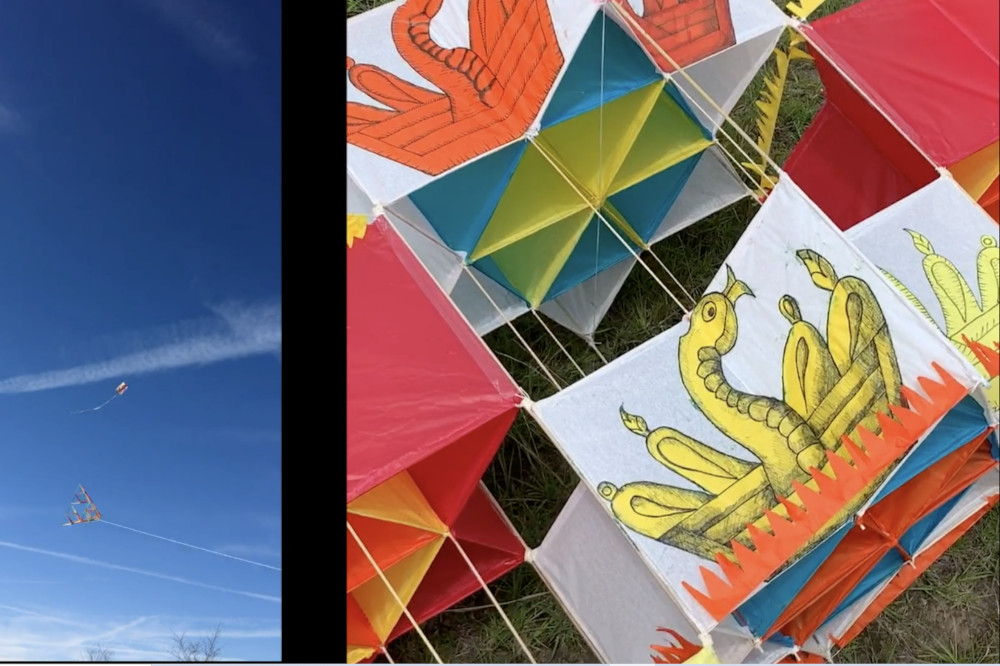
Flying high
Another example? A twist to high-flying kites crafted in a Mesoamerican tradition by artists from the Rasquache program in Mexico. The installation BordersBordados: A Rasquache Time Machine, part of the first Beyond-related exhibition at the Santa Cruz Museum of Art & History, encouraged viewers to consider emancipatory horizons beyond the present dystopia of violent, militarized border-zones that prevent passage to migrants seeking refuge from intolerable political and environmental conditions. To build their colorful kites that a viewer might imagine seeing flown above the U.S.–Mexico border wall, the artists used traditional needlework methods to combine re-engineered items associated with callous anti-immigration actions, including mylar blankets from border detention centers and tiki torches carried by white supremacists at hate rallies. “Imagine yourself in a future world,” said the artists in their online guide for creating the kites. “And speculate how our communities can survive and support one another.” The kites, they said, can “glide without resistance across borders and carry messages of hope.”
A third example, one of many described by Demos in his book, showcases a three-panel video installation created by British artist and filmmaker John Akomfrah. In Vertigo Sea (2015), Akomfrah reveals a shared conflict zone amongst seemingly unrelated histories, geographies, and inhabitants of the ocean by mixing lush imagery of vibrant marine life with images depicting century-spanning, violent human practices, including trans-Atlantic slave shipping, harpoon whaling, nuclear arms testing, and dangerous migrant crossings. Haunting music and background sounds accompany this montage of disparate images, all displayed without narration.
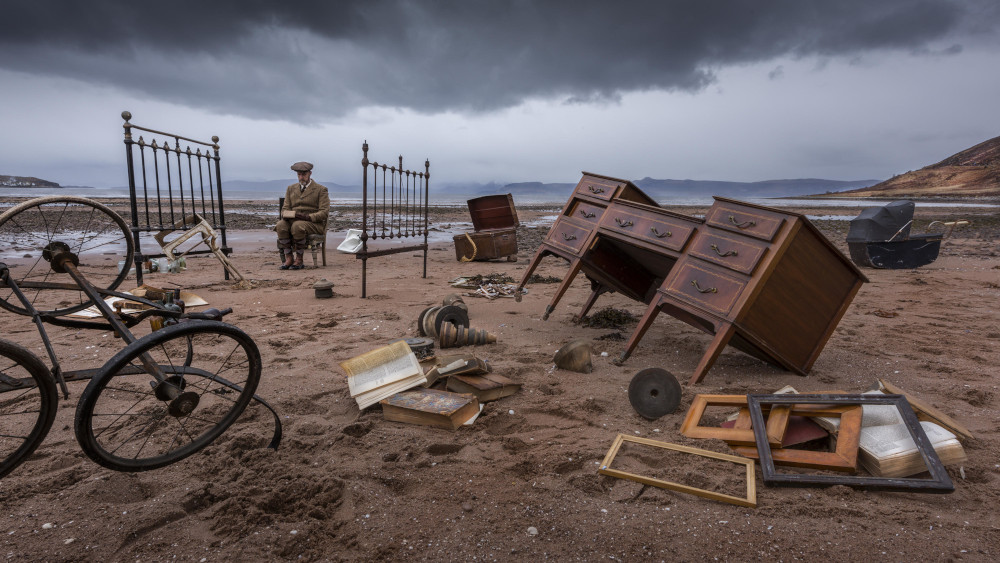
According to Demos, work like Vertigo Sea connects environmental scholarship, such as Blue Humanities research, to social justice and antiracist inquiry, such as Black Atlantic studies—areas seldom brought together in a complex dialog. The resulting artwork intertwines social and non-anthropocentric histories, providing a visually poignant and emotionally powerful impetus for creating a better future. “We are entering the endgame, the terminal point of democracy, of liberalism, of capitalism, of a cool planet, of the Anthropocene, of the world as we know it,” writes Demos. “Perhaps what Vertigo Sea offers is, ultimately, optimism, if not without its cruelties. Where past injustices have failed to utterly destroy their aftermath, we can maintain hope, despite all, of a different time to come.”
